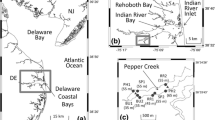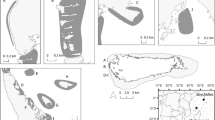Abstract
Grass shrimp are abundant residents of shallow-water habitats in US Atlantic and Gulf coast estuaries. Mark-recapture events determined the extent and direction of their movements in meso-tidal salt marsh creeks at North Inlet, South Carolina. Microwire-tagged Palaemonetes vulgaris demonstrated high fidelity for a dock in a subtidal channel. In the 48 days following release, 11 % of the 422 tagged shrimp were recaptured and 99 % of all recaptures were made there an average of 14 days post-release. Palaemonetes pugio, which favored the use of shallow intertidal areas, exhibited moderate fidelity for pools within creek beds with 53 % of the recaptured shrimp collected at the release site. Higher fidelity was observed for confluences of intertidal creeks and the subtidal channels. Of the 5565 shrimp released with coded microwire tags, 7.5 % were recaptured and 98 % of those recaptures were at release sites up to 53 days later. During another event, P. pugio released 235 m from their origin demonstrated relatively low fidelity for the new site and a lack of homing behavior. Of the 544 tagged shrimp, 3 % were recaptured; only 40 % of those recaptured were from the release site. Site fidelity is a mechanism by which previously discovered large and consistent differences in grass shrimp use of neighboring intertidal creek basins can be sustained over weeks, seasons, and years. Spatial variations and the tendency of these keystone organisms to resist relocation by tidal currents and occupy certain areas for extended periods should be considered in decisions about proposed alterations to creeks and shorelines.

Similar content being viewed by others
References
Able KW, Hales LS Jr (1997) Movements of juvenile black sea bass Centropristis striata (Linnaeus) in a southern New Jersey estuary. J Exp Mar Biol Ecol 213:153–167. doi:10.1016/s0022-0981(96)02743-8
Able KW, Hagan SM, Brown SA (2006) Habitat use, movement, and growth of young-of-the-year Fundulus spp. in southern New Jersey salt marshes: comparisons based on tag/recapture. J Exp Mar Biol Ecol 335(2):177–187. doi:10.1016/j.jembe.2006.03.004
Able KW, Vivian DN, Petruzzelli G, Hagan SM (2012) Connectivity among salt marsh subhabitats: residency and movements of mummichog (Fundulus heteroclitus). Est Coasts 35:743–753. doi:10.1007/s12237-011-9471-x
Allen DM, Haertel-Borer SS, Milan BJ, Bushek D, Dame RF (2007) Geomorphological determinants of nekton use of intertidal salt marsh creeks. Mar Ecol Prog Ser 329:57–71. doi:10.3354/meps329057
Allen DM, Luthy SA, Garwood JA, Young RF, Dame RF (2013) Nutrient subsidies from nekton in salt marsh intertidal creeks. Limnol Oceanogr 58(3):1048–1060. doi:10.4319/lo.2013.58.3.1048
Alon NC, Stancyk SE (1982) Variation in life-history patterns of the grass shrimp Palaemonetes pugio in two South Carolina estuarine systems. Mar Biol 68:265–276. doi:10.1007/BF00409593
Bretsch K, Allen DM (2006) Tidal migrations of nekton in salt marsh intertidal creeks. Est Coasts 29(3):474–486. doi:10.1007/BF02784995
Cannicci S, Fratini S, Vannini M (1999) Short-range homing in fiddler crabs (Ocypodidae, Genus Uca): a homing mechanism not based on local visual landmarks. Ethology 105:867–880. doi:10.1046/j.1439-0310.1999.00453.x
Christian RR, Allen DM (2014) Linking hydrogeomorphology and food webs in intertidal creeks. Est Coasts 37(Suppl):S74–S90. doi:10.1007/s12237-013-9657-5
Clark KL, Ruiz GM, Hines AH (2003) Diel variation in predator abundance, predation, risk, and prey distribution in shallow-water estuarine habitats. J Exp Mar Biol Ecol 287:37–55. doi:10.1016/S0022-0981(02)00439-2
Coen LD, Heck KJ Jr, Abele LG (1981) Experiments on competition and predation among shrimps of seagrass meadows. Ecology 62:1484–1493. doi:10.2307/1941505
Darcy MC, Eggleston DB (2005) Do habitat corridors influence animal dispersal and colonization in estuarine systems? Landsc Ecol 20:841–855. doi:10.1007/s10980-005-3704-y
Daugomah JW, Key PB, West JB, Shea NR, McDaniel S, Pennington PL, Fulton MH (2014) Relationship between land use classification and grass shrimp Palaemonetes spp. population metrics in coastal watersheds. Environ Monit Assess 186:3445–3453. doi:10.1007/s10661-014-3629-5
Davis JLD, Metcalfe WJ, Hines AH (2003) Implications of a fluctuating fish predator guild on behavior, distribution, and abundance of a shared prey species: the grass shrimp Palaemonetes pugio. J Exp Mar Biol Ecol 293:23–40. doi:10.1016/S0022-0981(03)00122-9
Eggleston DB, Etherington LL, Ellis WE (1998) Organism response to habitat patchiness: species and habitat-dependent recruitment of decapods crustaceans. J Exp Mar Biol Ecol 223:111–132. doi:10.1016/s0022-0981(97)00154-8
Fitz ES, Meredith WH, Lotrich VA (1975) Fall and winter movements and activity level of the mummichog, Fundulus heteroclitus, in a tidal creek. Chesap Sci 16:211–215. doi:10.2307/1350898
Forsee RA, Albrecht M (2012) Population estimation and site fidelity of the land crab Cardiosoma guanhumi (Decapoda: Brachyura: Gecarcinidae) on Vieques Island, Puerto Rico. J Crust Biol 32(3):435–442. doi:10.1163/193724012X626467
Gibson RN (1999) Movement and homing in intertidal fishes. In: Horn MH, Martin KLM, Chotkowski MA (eds) Intertidal fishes: life in two worlds. Acad Press, San Diego, pp 97–125
Goddard SM, Forward RB Jr (1989) The use of celestial cues in the offshore escape response of the shrimp, Palaemonetes vulgaris. Mar Behav Physiol 16:11–18. doi:10.1080/10236248909378737
Green BC, Smith DJ, Grey J, Underwood GJC (2012) High site fidelity and low site connectivity in temperate salt marsh fish populations: a stable isotope approach. Oecologia 168:245–255. doi:10.1007/s00442-011-2077-y
Gregg CS, Fleeger JW (1998) Grass shrimp Palaemonetes pugio predation on sediment- and stem-dwelling meiofauna: field and laboratory experiments. Mar Ecol Prog Ser 175:77–86. doi:10.3354/meps175077
Herrnkind WF (1972) Orientation of shore-living arthropods, especially the sand fiddler crab. In: Winn H, Olla B (eds) Behavior of marine animals: invertebrates, vol 2. Plenum Press, New York, pp 1–59
Holland AF, Sanger DM, Gawle CP, Lerberg SB, Santiago MS, Riekerk GHM, Zimmerman LE, Scott GI (2004) Linkages between tidal creek ecosystems and the landscape and demographic attributes of their watersheds. J Exp Mar Biol Ecol 298:151–178. doi:10.1016/S0022-0981(03)00357-5
Irlandi EA, Crawford MK (1997) Habitat linkages: the effect of intertidal saltmarshes and adjacent subtidal habitats on abundance, movement, and growth of an estuarine fish. Oecologia 110:222–230. doi:10.1007/s004420050154
Johnson EG, Eggleston DB (2010) Population, survival, and movement of blue crabs in estuarine salt marsh nurseries. Mar Ecol Prog Ser 407:135–147. doi:10.3354/meps08574
Kahn RN, Merchant HC, Knowlton RE (1997) Effects of macrophytic cover on the distribution of grass shrimps, Palaemonetes pugio and P. vulgaris. Invertebr Biol 116(3):243–247. doi:10.2307/3226900
Kingsley-Smith PR, Joyce RE, Arnott SA, Roumillat WA, McDonough CJ, Reichert MJM (2013) Habitat use of intertidal Eastern Oyster (Crassostrea virginica) reefs by nekton in South Carolina estuaries. J Shellfish Res 31(4):1009–1021. doi:10.2983/035.031.0413
Kneib RT (1997) The role of tidal marshes in the ecology of estuarine nekton. Oceanogr Mar Biol Ann Rev. 35:163–220
Kneib RT (2000) Salt marsh ecoscapes and production transfers by estuarine nekton in the southeastern United States. In: Weinstein MP, Kreeger DA (eds) Concepts and controversies in tidal marsh ecology. Kluwer Academic Publications, New York, pp 267–291
Kneib RT, Huggler MC (2001) Tag placement, mark retention, survival and growth of juvenile white shrimp (Litopenaeus setiferus Perez Farfante, 1969) injected with coded wire tags. J Exp Mar Biol Ecol 266:109–120. doi:10.1016/s0022-0981(01)00347-1
Kneib RT, Wagner SL (1994) Nekton use of vegetated marsh habitats at different stages of tidal inundation. Mar Ecol Prog Ser 106:227–238. doi:10.3354/meps106227
Kunz AK, Ford M, Pung OJ (2006) Behavior of the grass shrimp Palaemonetes pugio and its response to the presence of the predatory fish Fundulus heteroclitus. Am Midl Nat 155:286–294. doi:10.1674/0003-0031
Langdon J, Herrnkind WF (1985) Visual shape discrimination in the fiddler crab Uca pugilator. Mar Behav Physiol 11:313–325. doi:10.1080/10236248509387056
Lebata MAJH, Walton ME, Binas JB, Primavera JH, LeVay L (2012) Identifying mangrove areas for fisheries enhancement: population assessment in a patchy habitat. Aq Cons Mar Freshw Ecosyst 22:652–664. doi:10.1002/aqc.2235
Leight AK, Scott GI, Fulton MH, Daugomah JW (2005) Long term monitoring of grass shrimp Palaemonetes spp. population metrics at sites with agricultural runoff influences. Integr Comp Biol 45:143–150. doi:10.1093/icb/45.1.143
Lotrich VA (1975) Summer home range and movements of Fundulus heteroclitus (Pisces: Cyprinodontidae) in a tidal creek. Ecology 56(1):191–198. doi:10.2307/1935311
Lundberg J, Moberg F (2003) Mobile link organisms and ecosystem functioning: implications for ecosystem resilience and management. Ecosystems 6:87–98. doi:10.1007/s10021-002-0150-4
McGrath P, Austin HA (2009) Site fidelity, home range and tidal movements of white perch during the summer in two small tributaries of the York River, Virginia. Trans Am Fish Soc 138:966–974. doi:10.1577/T08-176.1
Moore S, Perrin S (2007) Seasonal movements and resource use patterns of resident horseshoe crab (Limulus polyphemus) populations in a Maine, USA estuary. Est Coasts 30(6):1016–1026. doi:10.1007/BF02841392
Potthoff MT, Allen DM (2003) Site fidelity, home range, and tidal migrations of juvenile pinfish, Lagodon rhomboides, in salt marsh creeks. Env Biol Fish 67:231–240. doi:10.1023/A:1025874712710
Ruiz GM, Hines AH, Posey MH (1993) Shallow water as a refuge habitat for fish and crustaceans in non-vegetated estuaries: an example from Chesapeake Bay. Mar Ecol Prog Ser 99:1–16. doi:10.3354/meps099001
Schaffenmeister BE, Hiddink JG, Wolff WJ (2006) Habitat use of shrimps in the intertidal and shallow subtidal seagrass beds of tropical Banc d’ Arguin, Mauritania. J Sea Res 55:230–243. doi:10.1016/j.seares.2005.10.1003
Shervette VR, Gelwick F, Hadley N (2011) Decapod utilization of adjacent oyster, vegetated marsh, and non-vegetated bottom habitats in a Gulf of Mexico estuary. J Crust Biol 31(4):660–667. doi:10.1651/10-3360.1
Sikora WB (1977) The ecology of Palaemonetes pugio in a southeastern salt marsh ecosystem with particular emphasis on production and trophic relationships. Dissertation, University of South Carolina
Silva ACF, Boneventura DM, Thompson RC, Hawkins SJ (2014) Spatial and temporal patterns of subtidal and intertidal crab excursions. J Sea Res 85:343–348. doi:10.1016/j.seares.2013.06.006
Sogard SM, Able KW (1994) Diel variation in immigration of fishes and decapods crustaceans to seagrass habitat. Estuaries 17:622–630. doi:10.2307/1352410
Stone RP, O’Clair CE (2002) Behavior of female Dungeness crabs, Cancer magister, in a glacial southeast Alaska estuary: homing, brooding site fidelity, seasonal movements, and habitat use. J Crus Biol 22(2):481–492. doi:10.1163/200221975-99990256
Teo SLH, Able KW (2003) Habitat use and movement of the mummichog (Fundulus heteroclitus) in a restored salt marsh. Estuaries 26(3):720–730. doi:10.10007/BF02711983
Thorp JH (1976) Interference competition as a mechanism of coexistence between two sympatric species of the grass shrimp Palaemonetes (Decapoda: Palaemonidae). J Exp Mar Biol Ecol 25:19–35. doi:10.1016/0022-0981(76)90073-3
Thyssen L, Triay-Portella R, Santana del Pino A, Castro JJ (2014) Homing behavior of rock pool blenny Parablennius parvicornis (Pisces: Blennidae). J Nat Hist 48:1169–1179. doi:10.1080/00222933.2013.859314
Tupper M, Able KW (2000) Movements and food habits of striped bass (Morone saxatilis) in Delaware Bay (USA) salt marshes: comparison of a restored and a reference marsh. Mar Biol 137:1049–1058. doi:10.1007/s002270000421
Ugolini A, Talluri P, Vannini M (1989) Astronomical orientation and learning in the shrimp Palaemonetes antennarius. Mar Biol 103:489–493. doi:10.1007/BF00399580
Webb S, Kneib RT (2004) Individual growth rates and movement of juvenile white shrimp (Litopenaeus setiferus) in a tidal marsh nursery. Fish Bull 102:376–388
Weinstein MP, O’Neil SP (1986) Exchange of marked juvenile spots between adjacent tidal creeks in the York River estuary, Virginia. Trans Am Fish Soc 115:93–97. doi:10.1577/1548-8659
Welsh BL (1975) The role of grass shrimp Palaemonetes pugio in a tidal marsh ecosystem. Ecology 56:513–530. doi:10.2307/1935488
White GE, Brown C (2013) Site fidelity and homing behavior in intertidal fishes. Mar Biol 160:1365–1372. doi:10.1007/s00227-013-2188-6
Acknowledgments
We thank C. Mitchell (Rogers Undergraduate Fellow at Cornell College) for participation in the project. The Coastal Carolina University (CCU) Department of Marine Science (R. Young) supported K. Ludwig’s (Yozzo’s) undergraduate research. The CCU Honors Program (P. Whalen) and College of Sciences (M. Roberts) supported K. Stroud’s undergraduate Honors thesis. Additional field and laboratory assistance was provided by C.T. Armstrong, S. Dingley, V. Hartigan, P. Kenny, S. Krug, and R. Tremont. We also thank the staff of the Baruch Marine Field Laboratory of the University of South Carolina for support during all phases of the study. This is contribution number XXXX from the Belle W. Baruch Institute for Marine and Coastal Sciences.
Author information
Authors and Affiliations
Corresponding author
Additional information
Communicated by X. Irigoyen.
Rights and permissions
About this article
Cite this article
Allen, D.M., Harding, J.M., Stroud, K.B. et al. Movements and site fidelity of grass shrimp (Palaemonetes pugio and P. vulgaris) in salt marsh intertidal creeks. Mar Biol 162, 1275–1285 (2015). https://doi.org/10.1007/s00227-015-2668-y
Received:
Accepted:
Published:
Issue Date:
DOI: https://doi.org/10.1007/s00227-015-2668-y




